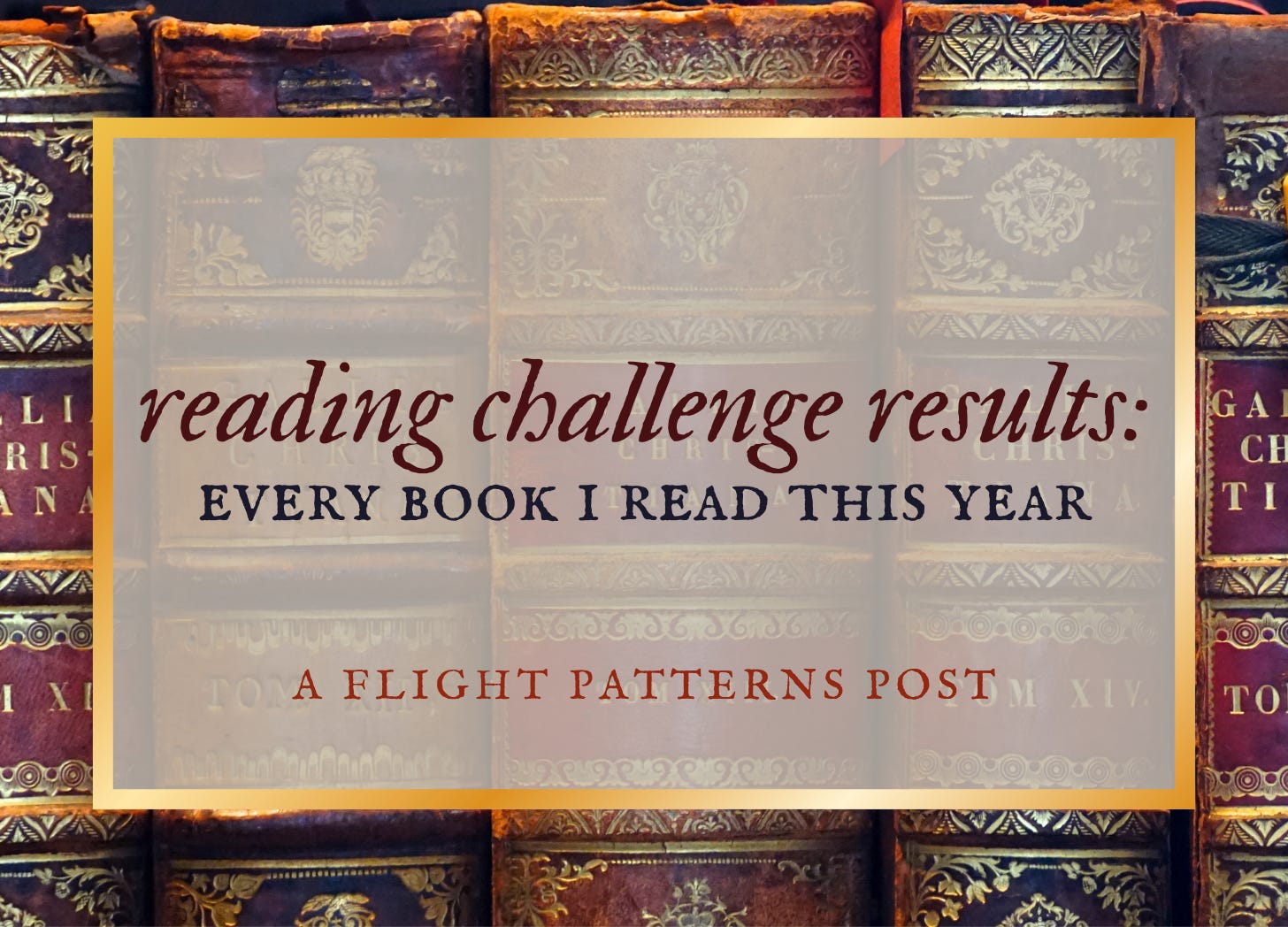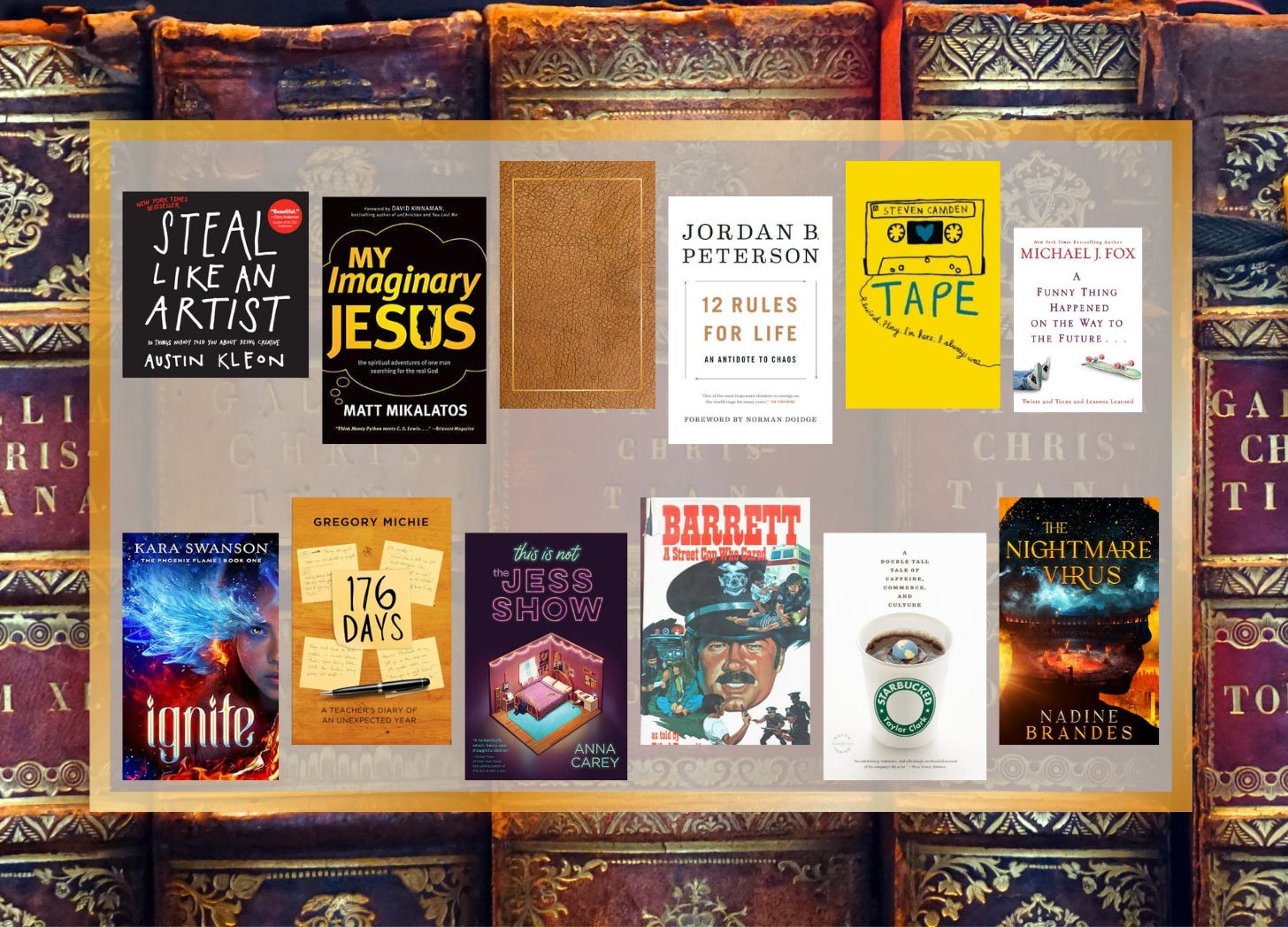reading challenge results: every book i read this year.
I read a statistic once that the average person after highschool reads one book a year. Well, I thought that was a sad statistic, so at the beginning of this year, I set a goal to read a book a month. It wasn’t much, but it was better than nothing, and got me back into the groove of reading.
January
Steal Like An Artist: 10 things no one told you about being creative by
This was a short, simple book about creativity that originated as content that Kleon was posting on his blog. If you’re a person interested in creativity, you should read this book for no other reason than because it’s a quick and beautiful read. Some of his points I hadn’t heard before, and some I had heard but appreciated the reminder.
His thoughts on balancing the digital portion of art with the analog portion were especially insightful for me.
[redacted]
I read a book on the pharmaceutical drug trial system, that while well researched and well written, contained some pretty intense content that I don’t feel comfortable sharing on Flight Patterns.
February
My Imaginary Jesus: the spiritual adventures of one man searching for the real God by
Man oh man I did not know what to expect from this book… I’ve read several other of Matt’s books (and even interviewed him.) My Imaginary Jesus was a gripping, satiric, and convicting read. The book asks readers to re-examine their perspectives of what they believe Jesus to be. This book can come across as a little irreverent, but it’s to show the insincerity in our souls. (This book should be mandatory reading for anyone thinking about writing worship songs.)
March
Danish Fairy Tales by Grundtvig, Svend, tr. by J. Grant Cramer.
(read this book online for free)
You know I love fairytale retellings, but I also enjoy the originals. This book was published in 1919 and contains 14 Danish fairytales.
I read it to gain inspiration for a school assignment, but it was not assigned reading. (there was a teacher that made us write a short story every week, and I was exhausted, so the chaotic side of me thought it would be interesting to write a surreal fairytale retelling… anyway comment if you want to read the tale of Molly and the Giant’s Rooster.)
Fairy tales are already pretty surreal, and Grundtvig’s Danish ones are no less. In this book one will find very familiar fairy tale motifs (princesses and quests and talking animals) but the fairytales themselves are bizarre and likely unfamiliar to most people.
April
In April I started a few books but lacked the time and energy to finish them.
May
12 Rules for Life: An Antidote to Chaos by Jordan B. Peterson.
This is a self help book about living a more focused life.
I was expecting this to be in the same vein as How to Win Friends and Influence People by Dale Carnegie or 7 Habits of Highly Effective People by Stephen Covey, which it wasn’t. If you get the chance to read through this, there are good takeaways, but I wouldn’t recommend adding it to your bookshelf.
In my opinion, this book was longer than it needed to be. It had several great thinking points but I didn’t agree with everything he said. A note to people who read this: he does not claim to be a Christian, and his Bible quotations are often out of context, so use discernment when reading this.
Tape by Camden Steven
I picked up this book because I liked the cover, but it’s another book I don’t know if I would recommend, just because the plot was slow and fairly unimaginative. The prose on the other hand, was excellent. I appreciated that the details that stood out to the main characters matched their personalities. If you’re ever in the mood for a slow, angsty YA book set in UK during the 90’s.1 CWs: There were also a couple off color remarks and definitely a heavier tone so I would recommend this one for older readers.
June
A Funny Thing Happened on the Way to the Future... by Michael J. Fox
Another short book and also humorous. Fox compares how his “school of hard knocks” education taught him many of the lessons presented on college campuses. He also shared some behind the scenes stories from the making of Back to the Future, which is the main reason I picked up the book in the first place.
Ignite by Kara Swanson
As part of Kara’s street team, I was provided an ARC to review. You can read the full post here.
July
August
176 Days: A Teacher's Diary of an Unexpected Year by Gregory Michie
This is sort of an epistolary non-fiction work, where it’s written in diary/letter entries. I found this on Substack through
’s newsletters. In 176 Days, veteran teacher unexpectically is asked to teach classes from every grade level about media literacy in a Chicago school.I’m fascinated to read about teachers because of my interest in the Humanities. My personal education has been a mix of dual-immersion, online charter, traditional public school, homeschooling with the Classical method, and dual enrollment at a local highschool. (And now University.) Reading things written by teachers gives me a very matter-of-fact, practical perspective on what’s going on across the country, and how it affects the average person.
Multiple times when I was reading 176 Days, I found myself very impressed by Greg Michie for teaching elementary school kids skills that I didn’t even learn in college media classes. I read this while working a caregiver in a nursing home and I feel it helped bolster my compassion and empathy for people for came from different backgrounds.
October
This Is Not The Jess Show by Anna Carey
This a great concept, and I picked it up because I really enjoyed Running Out Of Time by Margaret Peterson Haddix. However, I didn’t care for how it was executed. This would make a great book for people interested in the entertainment industry or the affect of media on children, but since it doesn’t go deep enough into the themes it raises, it would be best as an interesting jumping-off point for a discussion group.
The other potentially interesting part of the book was the 90’s references, but even those felt forced. The POV character has supposedly grown up with these things, yet feels the need to point them out in a way that feels unauthentic.
Also in October: I read a graphic novel for the art (the plot was pretty dry.)
November
Starbucked: A Double Tall Tale of Caffeine, Commerce, and Culture by Taylor Clark
While this book (from 2008) is a little out of date, the first half offers a fasinating look at the history of coffee and the marketing strategy behind the rise of Starbucks. It talks about objections people have towards Starbucks in a fair way, but also dispells myths about the corporation. This book is a remarkable piece of journalism and speaks into how easy it is for people to form strong emotional associations with something like coffee or a place like Starbucks. Whether you like or dislike Starbucks, this book covers the cultural shifts and assumptions that are connected to the company.
Barrett: A Street Cop Who Cared by Ethel Barrett
This book was written in the late 70’s about a cop (the author’s son, although that’s not shown in the book) who talks and prays a gunman out of a hostage situation and later goes on to start a home church in a secular beach community.
This book was intersting because there was a certain flavor of Christianity in the 70’s that made its way into the old Sunday School and homeschool books, the ones where the moral of the story was often in the title and written in italics (usually in a rhyme) inside the book. This book was written about an adult, for adults and it still had that specific flavor, a childlike piousness and zeal for spreading the Gospel through tracts and talking to strangers.
It’s not bad, it just can come across as a little naive and preachy to current-day Christians who live in a different culture.
December
The Nightmare Virus by Nadine Brandes
(Read my review of Romanov by Nadine Brandes)
This author writes books that are complex, to say the least. But good. This book also has heavier themes. It alternates between a dystopian reality and a odd, Romanesque dream world. I personally have a hard time reading books set in dream worlds, it feels like it messes with my brain.
The main character seeks a cure to the mysterious Nightmare Virus, a disease that is causing people to sleep more and more before falling asleep and not waking up. When the MC catches the virus, he enters a dark, strange world called the Nightmare.
I do appreciate how the Nightmare is connected with the real world, things that happen in the Nightmare have consequenses in the real world. This story revolves around the power of the imagination, and how easy it can be to justify negative imagination in hard times.
And that, my friends, the the entirety of I read (outside of school) this year. I’m really glad I made a goal, small as it was, because it made me be intentional with my books. Next year, I hope to read 24 books, and also build a tbr list to deliberately read some classics that I didn’t get to in highschool.
A few notes for the nit-picky readers out there:
Yes, the author uses em-dashes instead of quotation marks. This is fairly common in European typography, it’s not some random thing he made up.
Yes, the characters say Mom and not Mum. This is a dialect of English common around Birmingham (central UK.)






